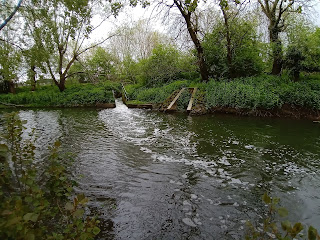We are picking up from where we left off last week in the village of Long Lawford just west of Rugby.
The walk today promises much! Including one of my most favourite of features on the landscape. Hope that has whetted your appetite avid reader? I will keep my powder dry until slightly later though. Which might not be easy given the forecast for heavy afternoon showers. The waterproofs are packed once again so that usually means we will be fine.
We are off in a clockwise direction and are soon on to the Shakespeare's Avon Way and heading off towards Church Lawford.
There has been so much rain over the last couple of weeks that we are back to sodden muddy fields. That can only mean one thing 'cleggy' boots!
 |
| Waterlogged Fields |
 |
| First sight of the River Avon |
 |
| St Peter's - Church Lawford |
 |
We come across some remnants of an old watermill that dates back to around 1924. The mill has now been demolished, but the mill pool and a footbridge are still there.
The next point of interest is the site of the Church of St Laurence. that was built during the Medieval period. It continued to be used until the end of the 18th century. It fell into disrepair and all but the tower was pulled down. The tower now belongs to Hall Farm; the base of the tower has been used as a chicken house in the past and is now being used for storage.
 |
We pick up the longest, narrowest and muddiest Bridleway you could ever hope to find. The only ones enjoying it are the Badgers judging by the number of setts and discarded bedding around.
Eventually the path leads us to the village of Brinklow. It has a very interesting village crest. There seems to be a Viking link judging by the sign. The village sits astride the Former Roman Fosse Way and was once a market town in the middle ages.
However the best thing in my opinion are the remains of a large Norman motte and bailey castle. It is known locally as 'The Tump' or simply 'The Big Hill'. It is one of the best examples of it's type in the country. The castle is believed to be built on the site of an ancient burial mound or Roman signal station.Be prepared for numerous photographs of the area. Of course I couldn't resist clambering the sixty odd feet to get to the top of this magnificent site.
 |
 |
That really was a treat! Maybe I just need to get out more? I blame Covid personally and the clean living and the fish diet.... On-wards we go with a spring in our muddied walking boot steps.Leaving Brinklow we pick up with our 'Old Friend' the Oxford Canal once again. It does feel that the title for this should be 'The Oxford Canal Walk' as we seem to have spent so much time on it! So please ready yourself for a few canal photos coming along shortly. We noticed some unusual 'ping pong balls' floating along in the water. Closer inspection was to reveal that these were in fact Duck eggs. Probably a nest had been washed away with all the rain and high water.
 |
| The Oxford Canal (Again) |
The skies have darkened and the wind has got up too, somehow the bad weather seems to have skirted around us. Hopefully our luck will hold on this last part of the walk?
Leaving the canal path and heading back towards Little Lawford we come across an oasis of peace and serenity. Much needed after having to negotiate a blocked off stile to make the exit. For some reason a layer of corrugated metal had been added to try and make it impassable. We just about managed to clamber over with little grace or finesse.
There are three lakes in total, two of which have an island wit trees and bushes. The Weeping Willow is home to a number of very noisy Herons. Commonly known as a 'Heronry' I do believe.
Directly underneath a Pen Swan is sitting on a nest of eggs. I dread to think what she gets showered with....
A cracking walk and we stayed largely dry. In total a distance of 10.15 miles.
 |
















































